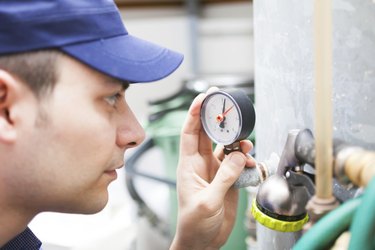
An important safety component of your water heater, the temperature and pressure relief valve is required by every plumbing code. In the event that the temperature of the water in the tank rises above a preset value -- usually 210 degrees Fahrenheit -- or the pressure rises above 150 psi, the valve opens, thereby averting a possible explosion. A leaking valve may be faulty, but it may just be doing its job.
The Temperature-Relief Function
Video of the Day
If the thermostat in your water heater fails and the water overheats, the T & P valve should open and let out a steady stream of water until enough cold water has entered the tank to bring the temperature down. The cycle will repeat until you fix the problem, and it's difficult to ignore. If your valve is properly installed with an overflow pipe, you'll see an ever-growing pool of water on the floor or in the overflow pan. This condition does not signify a problem with the valve, but a more serious problem with the heater. Turn off the power or the gas until you correct it.
Video of the Day
The Pressure-Relief Function
The pressure in your water tank can exceed safe limits for reasons that have nothing to do with temperature, and which also cause the valve to open and release water. If the pressure regulator in your house fails and allows the system pressure to exceed safe limits, the valve will open and release water continuously until the condition is corrected. You can test your system pressure by screwing a gauge onto any threaded cold-water faucet -- usually one in the laundry room. The problem could also be thermal expansion in the tank. This produces a periodic release of a small amount of water -- about a cup. If this happens, it means you don't have an expansion tank to absorb pressure when water is heating -- and you need one. Call a plumber.
A Bad Valve
If your valve is dripping or letting out periodic spurts of steam, it may simply be failing, and it usually isn't difficult to visually confirm this. You usually see rust around the tank near the valve, and the valve itself is often encrusted with mineral deposits. Some hot water heater manufacturers recommend replacing the valve every five years, but you don't necessarily have to do this. You can clean the mineral deposits from the valve by immersing it in vinegar overnight, and it may work after you do that. It's safer and more reliable to replace a malfunctioning valve, though.
Removing and Replacing the Valve
To remove a T & P valve, first turn off the electricity or gas and wait for the water to cool, which usually takes about 24 hours. Open a hot water faucet near the heater to release pressure and drain the tank until the water level is below the valve. Disconnect the overflow tube -- you may have to cut it -- and unscrew the valve with a wrench. Wrap plumbing tape around the threads of the freshly cleaned or new valve and screw the valve into the outlet, ensuring that the outlet is facing horizontal or down. Attach a 3/4-inch overflow pipe that extends to a few inches above floor level before turning on the water and power.